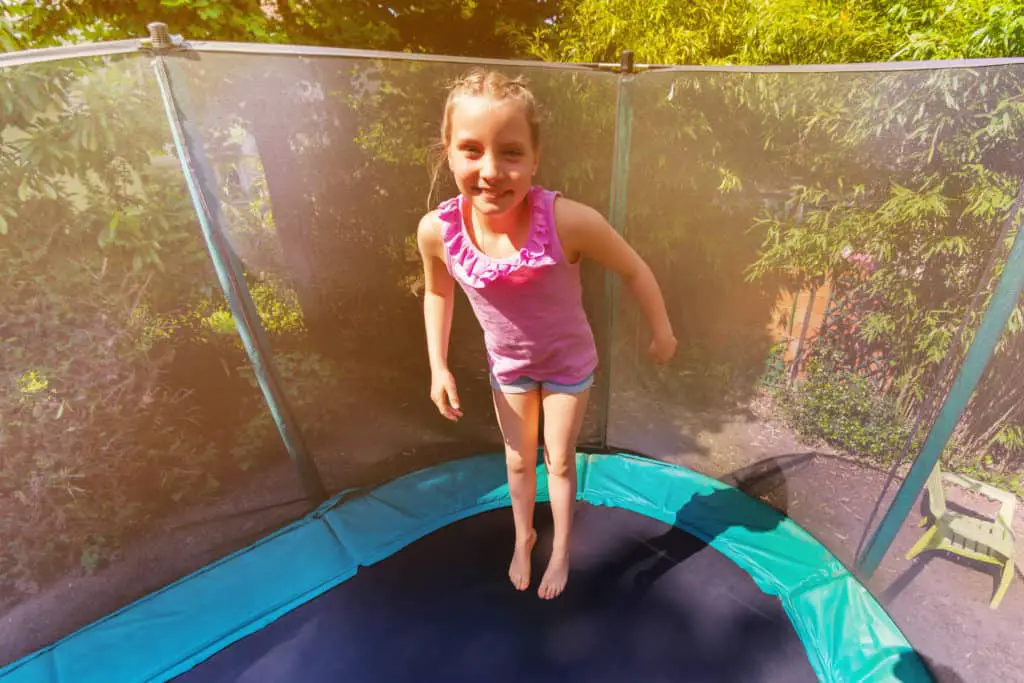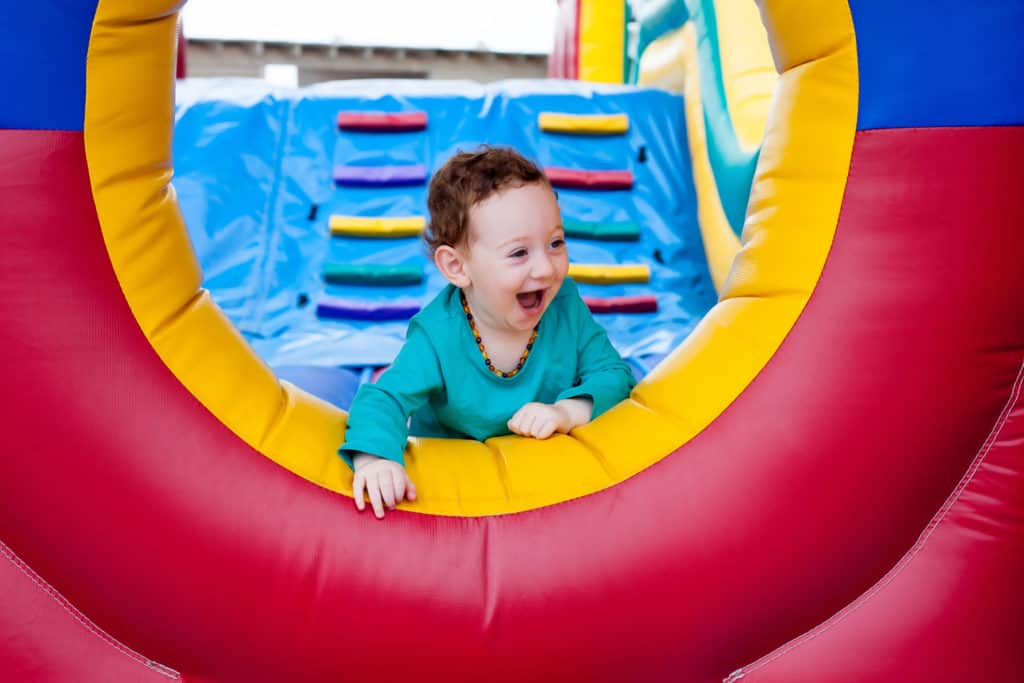This article is evidence-based, verified by Ashleigh Willis, a Neuroscience Ph.D. candidate.
It’s no surprise to hear that physical activity benefits children. The desire to partake in physical activity is innate within children. Kids love to run, jump, climb, and everything in between!
Recent research has revealed that exercise can have extra benefits for some children. This includes kids with autism and attention deficit hyperactivity disorders (ADHD).
An especially fun therapy has evolved over recent years – trampoline therapy.
If you’ve ever played on a trampoline as a child, you’ll likely remember the joy and exhilaration’—there an incredible high which comes from jumping high and experiencing a sense of weightlessness. But, bouncing high on a trampoline offers more than a fun way to play and exercise. Trampolining can provide a wealth of therapeutic benefits to mental and physical health. Research has shown that trampolining has many benefits for children with developmental disorders
It seems that simple exercise and play on a trampoline has many therapeutic benefits to those with autism and ADHD. Importantly, these benefits extend beyond the childhood years. Both adults and children benefit from various forms of trampoline-based therapeutic interventions.
Why is exercise so beneficial for people with autism and ADHD?

Before we delve into trampoline therapy, let’s look at the unique ways that physical activity can benefit people with autism and ADHD.
We all understand the importance of exercise for our health and well-being. Regular exercise improves muscle strength, heart, and respiratory health. It also helps with mental health and clarity. However, for those with autism and ADHD, physical activity can provide a unique form of movement medicine.
Autism Spectrum Disorder
Autism spectrum disorder symptoms include difficulties in motor skills and coordination. Many individuals with autism struggle with a limited range of movement and are prone to repetitive motions.
Outside of the physical issues, children and adults with autism can experience high levels of stress and anxiety. These stem from the challenges they face in social communication and interacting with the world around them. People with autism can also struggle with attention, self-regulation, and impulse control.
Engaging in any type of physical exercise helps to relieve many of these symptoms. Exercise can also improve the abilities of those with autism. The benefits are wide-ranging and unique to the individual. However, research has highlighted a few key results as a consequence of exercise:
- Reduced anxiety and stress-related tensions. Exercise reduces stress hormones like cortisol, and these hormones are the leading players in the anxiety circuits of the body. Reducing these hormones can provide a substantial calming effect.
- An increased range of movement. This helps children to express emotions through body movement in more diverse ways. Exercise has clear physical benefits, but also may aid in non-verbal social communication.
- Improvements in general motor abilities and coordination.
- Improved posture and gait
People with autism will also benefit from a general increase in muscle strength and stamina as a result of exercise. These improvements can further aid their movement abilities.
ADHD
ADHD is a form of mental health condition which can cause abnormal levels of hyperactivity and impulsive behavior. Both adults and children with ADHD find it difficult to focus on a single task, maintain attention, and finish tasks. Often people with ADHD will struggle with emotional regulation as well.
Adults and children can be prescribed stimulants or other medications as a way of controlling their symptoms. These stimulant medications work by altering levels of brain-based molecules called ‘neurotransmitters.’ These neurotransmitters control neuronal communication.
When these molecules become imbalanced, we can observe a wide range of symptoms. In the case of ADHD, researchers have found that the neurotransmitter ‘dopamine’ becomes depleted. Dopamine gives us feelings of reward from various activities. We see ‘dopamine seeking’ hyperactive behaviors when levels of this molecule are reduced.
Pharmacological interventions exist to regulate the levels of these neurotransmitters. But, there’s a much more cost-effective and straightforward answer: exercise. When we exercise, our brains release high levels of dopamine. This means that physical activity can have the same benefits for people with ADHD as prescribed pharmaceuticals.
Many studies have shown that regular exercise produces some significant improvements to the symptoms of ADHD. These include:
- Decreased stress
- Enhanced memory, concentration, and attention
- Improved impulse control
- Improvements to ‘executive function’. Executive function refers to a variety of cognitive skills. Skills included in executive function relate to planning, organization, and decision making.
Biological studies have revealed that exercise increases levels of a molecule called brain-derived neurotrophic factor (BDNF). BDNF is a protein that has essential roles in learning and memory. BDNF is in short supply in the brains of people with autism and ADHD. Hence, any elevation in the amount of these tiny molecules is excellent news for people with these conditions.
Why trampoline therapy?

Trampoline therapy sounds like something we’d all love to take part in! However, compared to other forms of physical activity, the treatment offers unique benefits. These extra benefits are particularly helpful for people with autism and ADHD.
Trampoline therapy, sometimes referred to as ‘Rebound Therapy,’ offers a unique exercise experience. It’s often the case that group sports can often be overwhelming for children with autism or ADHD. In the case of adults, formal exercise environments such as gyms or exercise classes can be intimidating or difficult to approach. Trampolining may provide the perfect autism and ADHD-friendly alternative. Trampolining provides exercise benefits, but avoids pressures of traditional sports or exercise settings. There’s also a healthy dose of joy sprinkled in, which is great for everyone!
Benefits to sensory imbalances
Trampolining has some extra benefits to children and adults who have to deal with sensory imbalances. This is particularly important in the case of autism. People with autism will often seek relief from these imbalances. They do so through repetitive movements such as rocking, swinging, and fidgeting. The act of bouncing on a trampoline is an excellent way to stimulate these soothing movements in a safe way.
Fostering calm, clarity and presence
Jumping on a trampoline often produces an effect of ‘weightless.’ Weightlessness is likely responsible for the laughter and joy we experience. This feeling is also thought to have many positive effects on the brain, from calming stress to inducing better concentration. In the case of ADHD, a sense of mental clarity and focus can be found because the user needs to focus in order not to fall.
Trampolining improves many emotional and interpersonal issues in teenagers with ADHD. In particular, trampoline therapy can promote feelings of independence and foster a sense of control and power. Combining trampolining with other therapies enhances these benefits. Studies have shown this helps teenagers follow their treatment plan. This type of treatment can also help to improve performance in their formal education.
Increased release of dopamine
Research suggests that the sense of freedom experienced when jumping on a trampoline may give this activity and extra boost. Since the movement provides a unique form of excitement, the brain may release more ‘feel good’ neurochemicals.
Some research has speculated the levels of dopamine produced by this type of exercise may be higher than that of usual physical activity. This suggestion remains to be fully supported by well-conducted experiments. However, the hypothesis may help to explain why trampolining is so helpful to people with ADHD.
Improvements to impulse control and self-regulation
Carers of people with autism and ADHD report improvements in impulse control and self-regulation. Research is yet to explore the mechanisms which underpin these improvements. It may be that that skills like control and balance are generalized to other areas of life.
Improvements to tactile defensiveness
Many people with autism spectrum disorder experience ‘tactile defensiveness.’ Tactile defensiveness is a fear or anxiety toward the touch of another person. In some case studies, touch-related anxiety completely disappears during trampoline therapy sessions. At the very least, trampolining appears to reduce this type of anxiety.
Confidence boosting
Many people who have autism spectrum disorder and ADHD suffer from feelings of inferiority. They can also lack confidence when comparing themselves to their peers. This often stems from feelings of being ‘different’ from others in the classroom. Sadly, these types of feelings can persist into adulthood.
Bouncing on a trampoline can provide an excellent way to combat these feelings.
Research has shown to reduce ‘learned helplessness.’ ‘Learned helplessness’ happens when a person experiences repeated stressful situations. This can be things like difficulties at school or with their peer-group. In these cases, individuals begin to believe that they are unable to control or change the situations. As a consequence, they no longer try to improve or modify, even is opportunities are available.
In line with this, the more practice a person has with jumping on a trampoline, the more they realize they can do it. This results in a confidence boost that can transfer to other aspects of daily life.
Ultimately, improving confidence through bouncing on a trampoline can spill over into other areas of life. Over time this can foster a positive mental attitude toward the challenges faced in life.
How is trampoline therapy implemented?

The beauty of trampoline therapy is how easy and flexible the activity is. Trampolining activities can be tailored entirely to the needs and desires of individuals and families.
is how easy and flexible the activity is. Trampolining activities can be tailored entirely to the needs and desires of individuals and families.
Trampoline therapy can take place in a formal setting, such as in a dedicated trampolining center. In these cases, the sessions may be guided by an instructor who will support the individual throughout the activity. This type of formal arrangement may be useful for children or adults who respond well to a strong sense of routine and schedule.
There are also a variety of organizations that provide in-school or community-based services. These services provide children with the opportunity to experience trampoline therapy. Services like these are helpful for children who feel more comfortable with new experiences in a familiar setting.
Of course, trampoline therapy is not limited to a formal environment. Trampoline based activities can be easily implemented at home. Luckily, without too much expenditure or adaptation to the home environment. Having an at-home facility means the movement is accessible whenever the individual desires. A particular benefit of the at-home environment is that it allows families and carers to get involved in the activity.
Having an at-home trampoline can be fantastic for families with multiple children and a special needs child. Often, children within the family may find it hard to interact with a sibling who has autism or ADHD. The pleasurable shared activity of trampolining can allow children to spend time together. It is often a valuable method of bonding.
Trampolining with siblings or peers in the home environment offers a way to improve social communication in a safe space. This can combat the feelings of isolation and loneliness, which people with autism and ADHD often face.
As with all at-home activities, it’s crucial to ensure the appropriate safety measures are in place. In the case of a trampoline, this means installing the soft padding and safety nets. It’s also essential that children are always supervised when jumping on a trampoline.
The benefits of exercise on physical and mental health are indisputable. In the case of autism and ADHD, maintaining physical activity may constitute an essential part of a treatment plan.
Trampoline therapy appears to offer a unique and optimal experience for children and adults with autism and ADHD. Research is yet to understand the biological underpinnings of these exceptional benefits. However, for now, the verdict seems clear. Trampoline therapy offers a simple intervention that can benefit individuals and their families.
There’s no reason for any of us not to enjoy a bounce!
Is EMDR Therapy Really The Next Superpower In Psychotherapy?

Ashleigh Willis is a final year Ph.D. candidate in Neuroscience at the University of Glasgow. Her research investigates the genetic and environmental contributors to mental health and neurodevelopmental conditions. Ashleigh has built research collaborations with McGill University and received specialist training at the Centre for Neuroscience at Montreal General Hospital, McGill University Health Centre. She is also an active member of the Society for Neuroscience. Ashleigh holds an Honours in Psychology, an MRes in Neuroscience, and is fascinated by the neuronal circuits which make us who we are. Ashleigh is passionate about providing a deeper understanding of mental health conditions and sharing an accurate and de-stigmatizing message through talks for organizations such as TEDx, Pint of Science, and the Scottish Funding Council.
You can follow Ashleigh on her Youtube channel here
References
- A New Approach to Substance Abuse Treatment: Adolescents and Adults With ADHD https://www.sciencedirect.com/science/article/pii/S0740547297000263

- https://launchtrampolinepark.com/blog/how-to-use-trampoline-therapy-for-autism/

- https://www.healthstatus.com/health_blog/health-fitness/the-benefits-of-trampolines-for-children-with-autism/

- https://add.org/trampoline-adhd-management/

- Aerobic exercise and chocolate as means for reducing learned helplessnesshttps://www.researchgate.net/publication/226098605_Aerobic_exercise_and_chocolate_as_means_for_reducing_learned_helplessness

- The effects of a home-based sensorimotor program on executive and motor functions in children with ADHD: a case series https://www.jstage.jst.go.jp/article/jpts/30/8/30_JPTS-2018-194/_pdf

- Effects of Exercise on Cognitive Performance in Children and Adolescents with ADHD: Potential Mechanisms and Evidence-based Recommendations https://www.ncbi.nlm.nih.gov/pmc/articles/PMC6617109/

